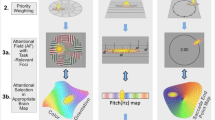Abstract
In binocular fusion, pairs of left and right stimuli yielding the same brightness perception constitute an equibrightness curve in a coordinate system whose ordinate and abscissa correspond to the left and right stimulus strengths. A neural network model is presented to elucidate the characteristics of the curve. According to the model, Fechner's paradox is due to the threshold characteristics of the neuron. If the shapes or movements are radically different between the left and right stimuli, the retinal rivalry is caused. That is, only the left stimulus is perceived at one moment and the right stimulus at another moment. The period of left or right eye dominance alternates randomly from time to time. The distribution of the period is approximate to the gamma distribution. In order to account for this fact, a neural network model is proposed, which consists of a pair of neurons receiving inputs with stochastic fluctuations. The computer simulation was carried out with satisfactory results. The model of retinal rivalry is integrated with that of brightness perception.
Similar content being viewed by others
References
Curtis, D.W., Rule, S.J.: Binocular processing of brightness information: a vector-sum model. J. Exp. Psychol., Hum. Percept. Perform. 4, 132–143 (1978)
Engel, G.R.: The autocorrelation function and binocular brightness mixing. Vision Res. 9, 1111–1130 (1969)
Fox, R., Rasche, F.: Binocular rivalry and reciprocal inhibition. Percept. Psychophys. 5, 215–217 (1969)
Fox, R., Todd, S., Bettinger, L.A.: Optokinetic nystagums as an objective indicator of binocuar rivalry. Vision Res. 15, 849–853 (1975)
Fry, G., Bartley, S.H.: The brilliance of an object seen binocularly. Am. J. Ophthal. 16, 687–693 (1933)
Goryo, K.: Stochastic variations in the retinal rivalry, the 30th Convention of Japan Psychology Association (1966)
Goryo, K.: Interaction in binocular vision. In: Handbook of sensation and perception, p. 401. Wada et al. (ed.). Tokyo: Seishin Shobo 1969
Hirai, Y., Fukushima, K.: A model of neural network finding the correspondence of binocular images. Trans. IECE 59-D, 3, 133–140 (1976)
Hochberg, J.: Contralateral suppressive fields of binocular combination. Psychon. Sci. 1, 157–158 (1964)
Hubel, D.H., Wiesel, T.N.: Cells sensitive to binocular depth in area 18 of the macaque monkey cortex. Nature 225, 41–42 (1970)
Julesz, B.: Binocular depth perception of computer-generated patterns. Bell Syst. Tech. J. 39, 1125–1162 (1960)
Leguire, L.E., Fox, R.: The open loop inhibition of binocular rivalry. ARVO (1979)
Lema, S., Blake, R.: Binocular summation in normal and stereoblind humans. Vision Res. 17, 691–695 (1977)
Levelt, W.J.M.: Binocular brightness averaging and contour information. Br. J. Psychol. 56, 1–13 (1965)
Levelt, W.J.M.: The alternation process in binocular rivalry. Br. J. Psychol. 57, 225–238 (1966)
Marr, D., Poggio, T.: Cooperative computation of stereo disparity. Science 194, 283–287 (1976)
Sanderson, K.J., Darian-Smith, I., Bishop, P.O.: The properties of the binocular receptive fields of lateral geniculate neurons. Exp. Brain Res. 13, 178–207 (1971)
Sugie, N., Suwa, M.: A neural network model of binocular depth perception. 1974 Nat. Conv. Rec. of Inst. Electron. Commun. Eng. Jpn. No. 59-3 (1974)
Sugie, N., Suwa, M.: A scheme for binocular depth perception suggested by neurophysiological evidence. Biol. Cybern. 26, 1–15 (1977)
Treisman, A.: Binocular rivalry and stereoscopic depth perception, Q. J. Exp. Psychol. 14, 23–37 (1962)
Thorn, F., Boynton, R.M.: Human binocular summation at absolute threshold. Vision Res. 14, 445–458 (1974)
De Weert, C.M.M., Levelt, W.J.M.: Binocular brightness combinations: additive and nonadditive aspects. Percept. Psychophys. 15, 551–562 (1974)
Author information
Authors and Affiliations
Rights and permissions
About this article
Cite this article
Sugie, N. Neural models of brightness perception and retinal rivalry in binocular vision. Biol. Cybern. 43, 13–21 (1982). https://doi.org/10.1007/BF00337283
Received:
Issue Date:
DOI: https://doi.org/10.1007/BF00337283




